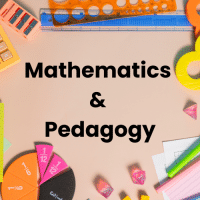CTET & State TET Exam > CTET & State TET Questions > To make learning interesting and easier for c...
Start Learning for Free
To make learning interesting and easier for children with learning disabilities, teachers can use mnemonics to remember complex order of things. For which type of learning disability can this mnemonic strategy be applied?
- a)Dyscalculia
- b)Dysgraphia
- c)Dyslexia
- d)Dyspraxia
Correct answer is option 'A'. Can you explain this answer?
| FREE This question is part of | Download PDF Attempt this Test |
Most Upvoted Answer
To make learning interesting and easier for children with learning dis...
Learning disability refers to a neurological disorder that causes cognitive impairment. Dyslexia, dysgraphia, dyscalculia, etc. are the most common learning disability.
Free Test
FREE
| Start Free Test |
Community Answer
To make learning interesting and easier for children with learning dis...
To make learning interesting and easier for children with learning disabilities, teachers can use mnemonics as a strategy. Mnemonics are memory aids that help individuals remember complex information or sequences by associating them with easily memorizable cues or patterns. This mnemonic strategy can be particularly helpful for children with dyscalculia.
Dyscalculia is a learning disability that affects a person's ability to understand and work with numbers. Individuals with dyscalculia may struggle with basic arithmetic operations, number sense, and mathematical reasoning. They may have difficulty remembering number facts, understanding number patterns, and organizing numerical information.
Using mnemonics can be beneficial for children with dyscalculia as it provides them with a structured and memorable way to remember complex order of things, such as mathematical formulas, steps in problem-solving processes, or sequences of operations. Mnemonics help break down information into smaller, more manageable chunks, making it easier for children with dyscalculia to process and remember.
Here is an example to illustrate how mnemonics can be used for children with dyscalculia:
Let's say a child with dyscalculia is struggling to remember the order of operations in mathematics: parentheses, exponents, multiplication and division (from left to right), and addition and subtraction (from left to right) - commonly known as PEMDAS.
- Mnemonic Example:
- Parentheses
- Exponents
- Multiplication and Division (from left to right)
- Addition and Subtraction (from left to right)
The teacher can create a memorable phrase or sentence using the first letter of each operation to create a mnemonic. For example: "Please Excuse My Dear Aunt Sally."
By associating the order of operations with a familiar phrase or sentence, the child with dyscalculia can remember the sequence more easily. They can recall the mnemonic whenever they encounter a math problem requiring the order of operations, helping them organize their thinking and solve the problem correctly.
Overall, using mnemonics as a strategy can enhance learning for children with dyscalculia by providing them with memorable cues and patterns to remember complex information or sequences. By breaking down information into smaller, more manageable chunks, mnemonics can support the cognitive processing and memory capabilities of children with dyscalculia, making learning more interesting and easier for them.
Dyscalculia is a learning disability that affects a person's ability to understand and work with numbers. Individuals with dyscalculia may struggle with basic arithmetic operations, number sense, and mathematical reasoning. They may have difficulty remembering number facts, understanding number patterns, and organizing numerical information.
Using mnemonics can be beneficial for children with dyscalculia as it provides them with a structured and memorable way to remember complex order of things, such as mathematical formulas, steps in problem-solving processes, or sequences of operations. Mnemonics help break down information into smaller, more manageable chunks, making it easier for children with dyscalculia to process and remember.
Here is an example to illustrate how mnemonics can be used for children with dyscalculia:
Let's say a child with dyscalculia is struggling to remember the order of operations in mathematics: parentheses, exponents, multiplication and division (from left to right), and addition and subtraction (from left to right) - commonly known as PEMDAS.
- Mnemonic Example:
- Parentheses
- Exponents
- Multiplication and Division (from left to right)
- Addition and Subtraction (from left to right)
The teacher can create a memorable phrase or sentence using the first letter of each operation to create a mnemonic. For example: "Please Excuse My Dear Aunt Sally."
By associating the order of operations with a familiar phrase or sentence, the child with dyscalculia can remember the sequence more easily. They can recall the mnemonic whenever they encounter a math problem requiring the order of operations, helping them organize their thinking and solve the problem correctly.
Overall, using mnemonics as a strategy can enhance learning for children with dyscalculia by providing them with memorable cues and patterns to remember complex information or sequences. By breaking down information into smaller, more manageable chunks, mnemonics can support the cognitive processing and memory capabilities of children with dyscalculia, making learning more interesting and easier for them.
Attention CTET & State TET Students!
To make sure you are not studying endlessly, EduRev has designed CTET & State TET study material, with Structured Courses, Videos, & Test Series. Plus get personalized analysis, doubt solving and improvement plans to achieve a great score in CTET & State TET.

|
Explore Courses for CTET & State TET exam
|

|
Similar CTET & State TET Doubts
To make learning interesting and easier for children with learning disabilities, teachers can use mnemonics to remember complex order of things. For which type of learning disability can this mnemonic strategy be applied?a)Dyscalculiab)Dysgraphiac)Dyslexiad)DyspraxiaCorrect answer is option 'A'. Can you explain this answer?
Question Description
To make learning interesting and easier for children with learning disabilities, teachers can use mnemonics to remember complex order of things. For which type of learning disability can this mnemonic strategy be applied?a)Dyscalculiab)Dysgraphiac)Dyslexiad)DyspraxiaCorrect answer is option 'A'. Can you explain this answer? for CTET & State TET 2024 is part of CTET & State TET preparation. The Question and answers have been prepared according to the CTET & State TET exam syllabus. Information about To make learning interesting and easier for children with learning disabilities, teachers can use mnemonics to remember complex order of things. For which type of learning disability can this mnemonic strategy be applied?a)Dyscalculiab)Dysgraphiac)Dyslexiad)DyspraxiaCorrect answer is option 'A'. Can you explain this answer? covers all topics & solutions for CTET & State TET 2024 Exam. Find important definitions, questions, meanings, examples, exercises and tests below for To make learning interesting and easier for children with learning disabilities, teachers can use mnemonics to remember complex order of things. For which type of learning disability can this mnemonic strategy be applied?a)Dyscalculiab)Dysgraphiac)Dyslexiad)DyspraxiaCorrect answer is option 'A'. Can you explain this answer?.
To make learning interesting and easier for children with learning disabilities, teachers can use mnemonics to remember complex order of things. For which type of learning disability can this mnemonic strategy be applied?a)Dyscalculiab)Dysgraphiac)Dyslexiad)DyspraxiaCorrect answer is option 'A'. Can you explain this answer? for CTET & State TET 2024 is part of CTET & State TET preparation. The Question and answers have been prepared according to the CTET & State TET exam syllabus. Information about To make learning interesting and easier for children with learning disabilities, teachers can use mnemonics to remember complex order of things. For which type of learning disability can this mnemonic strategy be applied?a)Dyscalculiab)Dysgraphiac)Dyslexiad)DyspraxiaCorrect answer is option 'A'. Can you explain this answer? covers all topics & solutions for CTET & State TET 2024 Exam. Find important definitions, questions, meanings, examples, exercises and tests below for To make learning interesting and easier for children with learning disabilities, teachers can use mnemonics to remember complex order of things. For which type of learning disability can this mnemonic strategy be applied?a)Dyscalculiab)Dysgraphiac)Dyslexiad)DyspraxiaCorrect answer is option 'A'. Can you explain this answer?.
Solutions for To make learning interesting and easier for children with learning disabilities, teachers can use mnemonics to remember complex order of things. For which type of learning disability can this mnemonic strategy be applied?a)Dyscalculiab)Dysgraphiac)Dyslexiad)DyspraxiaCorrect answer is option 'A'. Can you explain this answer? in English & in Hindi are available as part of our courses for CTET & State TET.
Download more important topics, notes, lectures and mock test series for CTET & State TET Exam by signing up for free.
Here you can find the meaning of To make learning interesting and easier for children with learning disabilities, teachers can use mnemonics to remember complex order of things. For which type of learning disability can this mnemonic strategy be applied?a)Dyscalculiab)Dysgraphiac)Dyslexiad)DyspraxiaCorrect answer is option 'A'. Can you explain this answer? defined & explained in the simplest way possible. Besides giving the explanation of
To make learning interesting and easier for children with learning disabilities, teachers can use mnemonics to remember complex order of things. For which type of learning disability can this mnemonic strategy be applied?a)Dyscalculiab)Dysgraphiac)Dyslexiad)DyspraxiaCorrect answer is option 'A'. Can you explain this answer?, a detailed solution for To make learning interesting and easier for children with learning disabilities, teachers can use mnemonics to remember complex order of things. For which type of learning disability can this mnemonic strategy be applied?a)Dyscalculiab)Dysgraphiac)Dyslexiad)DyspraxiaCorrect answer is option 'A'. Can you explain this answer? has been provided alongside types of To make learning interesting and easier for children with learning disabilities, teachers can use mnemonics to remember complex order of things. For which type of learning disability can this mnemonic strategy be applied?a)Dyscalculiab)Dysgraphiac)Dyslexiad)DyspraxiaCorrect answer is option 'A'. Can you explain this answer? theory, EduRev gives you an
ample number of questions to practice To make learning interesting and easier for children with learning disabilities, teachers can use mnemonics to remember complex order of things. For which type of learning disability can this mnemonic strategy be applied?a)Dyscalculiab)Dysgraphiac)Dyslexiad)DyspraxiaCorrect answer is option 'A'. Can you explain this answer? tests, examples and also practice CTET & State TET tests.

|
Explore Courses for CTET & State TET exam
|

|
Suggested Free Tests
Signup for Free!
Signup to see your scores go up within 7 days! Learn & Practice with 1000+ FREE Notes, Videos & Tests.
























